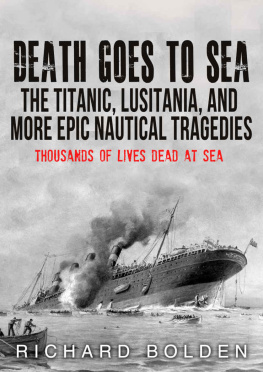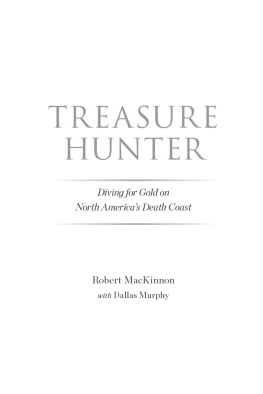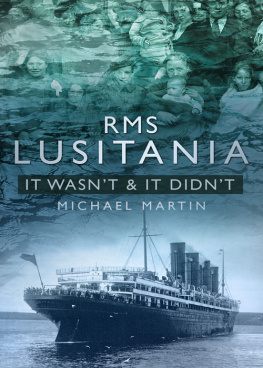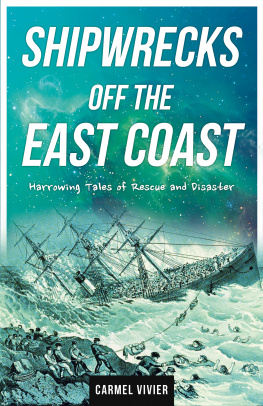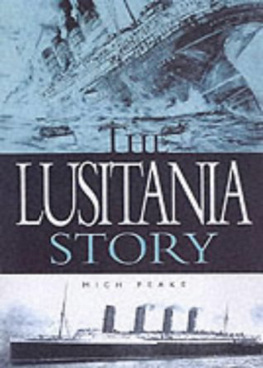Bolden - Death Goes To Sea: The Titantic, Lusitania, And More Epic Nautical Tradgedies
Here you can read online Bolden - Death Goes To Sea: The Titantic, Lusitania, And More Epic Nautical Tradgedies full text of the book (entire story) in english for free. Download pdf and epub, get meaning, cover and reviews about this ebook. year: 2015, genre: Adventure. Description of the work, (preface) as well as reviews are available. Best literature library LitArk.com created for fans of good reading and offers a wide selection of genres:
Romance novel
Science fiction
Adventure
Detective
Science
History
Home and family
Prose
Art
Politics
Computer
Non-fiction
Religion
Business
Children
Humor
Choose a favorite category and find really read worthwhile books. Enjoy immersion in the world of imagination, feel the emotions of the characters or learn something new for yourself, make an fascinating discovery.
Death Goes To Sea: The Titantic, Lusitania, And More Epic Nautical Tradgedies: summary, description and annotation
We offer to read an annotation, description, summary or preface (depends on what the author of the book "Death Goes To Sea: The Titantic, Lusitania, And More Epic Nautical Tradgedies" wrote himself). If you haven't found the necessary information about the book — write in the comments, we will try to find it.
Bolden: author's other books
Who wrote Death Goes To Sea: The Titantic, Lusitania, And More Epic Nautical Tradgedies? Find out the surname, the name of the author of the book and a list of all author's works by series.
Death Goes To Sea: The Titantic, Lusitania, And More Epic Nautical Tradgedies — read online for free the complete book (whole text) full work
Below is the text of the book, divided by pages. System saving the place of the last page read, allows you to conveniently read the book "Death Goes To Sea: The Titantic, Lusitania, And More Epic Nautical Tradgedies" online for free, without having to search again every time where you left off. Put a bookmark, and you can go to the page where you finished reading at any time.
Font size:
Interval:
Bookmark:
DEATH GOES TO SEA
The Titanic, Lusitania, And More Epic Nautical Tragedies
Thousands of Lives Dead at Sea
Richard Bolden
Table of Contents
Introduction
Death can follow a person anywhere. People can be murdered, vanish, or have an accident. Sometimes the specter of death takes a holiday on the high seas, which has led to numerous tragedies. Depending on how well you know your maritime history, you might have heard about each one of the accidental ship disasters within these pages. For those of you who pay more attention to the national media, you might recognize many of these disasters, and those who dont might remember only those from childhood history lessons.
But there are startling details yet to learn. For instance, did the captain really order the Titanic to go full speed ahead in dangerous waters? Was the Lusitania carrying secret munitions? Is it really possible for 7000 lives to be lost in 4 minutes?
Examining anthropological and psychological concepts provide a different way of viewing some of these ship disasters. This point of view also opens us up to new questions and will have you thinkinghow would I have reacted? Cruise through these pages to learn about some of the world's worst ship related disasters, with high death tolls in short periods of time.
Chapter 1:
The Titanic
The "Unsinkable" Titanic is a legend in Maritime history disasters. Whether many of us know the true accounting of the ship or just the Hollywood partially fictional version, there are questions about what really happened on the ship the fatal night of April 14, 1912. One question keeps coming upcould the disaster have been avoided or the loss of lives reduced if certain aspects had been different that night?
Many experts have researched the ship, sending ROVs into the depths to see the ship's final resting place, as well as reading investigation accounts from those who survived. Resurgence in the Titanic at the centennial has led to new hypotheses about what happened that fatal evening. It has now been suggested that Mr. Murdoch, who was in charge of the bridge at the time, reacted 30 seconds too slow to save the ship from disaster.
Putting all the blame aside for who should have done what, or the myths that are circulating because of the Hollywood film, one must wonder if the breadth of disaster had more to do with societal norms of the time. Did Captain Smith obtain an order from Bruce Ismay like the film says? Was the need to make the ship grand the reason the ship design was flawed, or was it flawed? Was it our need to separate classes that truly turned the Titanic's sinking into a horrible, unethical disaster?
In looking for answers, there are many variables as to what really occurred on the ship that fateful night. But it is possible to look at the history, myths, and assumptions in a different light. Assessing what occurred from an anthropological and psychological perspective may help us better understand how the horrors of that night could have escalated the death count.
The Titanic left Ireland with 2,240 passengers and crew on board. Included in the group of people were J. Bruce Ismay, the managing director for White Star Lines; Thomas Andrews, the ship builder; John Jacob Astor IV, the wealthiest passenger; Molly Brown, who was a widow and heiress of the time.
Only 705 passengers and crew survived, which means 1,535 passengers and crew died, either because they froze in the arctic waters or remained on the ship as it went down. Isidor and Ida Strauss retired to their cabin so they could perish together. Ida would not leave her husband behind, and Isidor would not take a seat with her because not all the women and children had gotten off the ship yet. Isidor was an older gentleman and, on account of his age, was told he could board a lifeboat.
Societal Norms may have Contributed
The 1900s slowly moved from extreme class distinctions to the situation we have today. Culturally, we still have stereotypical issues, such as looking at how a person dresses and assuming they have no money; however, it is not to the degree of earlier centuries. Certainly, there are some people who still do not associate with people out of their class. The standards of yesteryear, where the higher classes would simply look over anyone of a lower class, or consider the lower classes as nothing but servants, have lessened.
The changes started before World War I and became more significant after, because the world was reminded anyone can die blue-blooded or not. For the 1912 Titanic disaster, social classes were still very distinctive. Those who could afford the opulence had full run of the ship, and the lower classes were kept below. The lower passenger deck had two bathtubs, where those of the higher class had luxurious suites with individual tubs.
Assessing societal norms, which may have affected the night of April 14, one must look at the following:
Could more lifeboats have been added to the ship?Was it aesthetic or design that kept the number of lifeboats low?Was class the reason for the half-full lifeboats to be lowered, or panic?Was the cancelled lifeboat drill due to pleasing the passengers, or something else?Was the belief that the ship could not sink another reason for the loss of lives?Is full-speed ahead to arrive in New York the reason the disaster happened?The Lifeboat Situation
Based on the regulations of the time, only 16 lifeboats were required to be on the Titanic. The regulations were not based on the ship's passenger capacity, but the size of the vessel. The Titanic left port with all the lifeboats it was required to have. The reason the film and many sites attribute "class" distinctions as an issue has more to do with the number of people in the lifeboats as they left the deck. It is possible that more lifeboats could have been on the ship. It may also be linked to aesthetics as to why the builders did not have more. It can be a factor of cost versus confidence, as some resources have suggested.
The Titanic was hailed as an "unsinkable" ship; therefore, confidence by the ship owner and the builder may have factored into the number of lifeboats they planned for the ship, rather than the safety of passengers. The amount of money to be used for building the ship could have limited the number of boats in favor of making the Titanic more luxurious on the upper class decks.
Filling the Lifeboats
The History Channel states at least one lifeboat, with a capacity for 65 people, left the ship with 28 people on board. History1900s.about.com states the first lifeboat to launch had 24 people on board with a capacity for 65 total passengers. Lifeboat 1 had only 12 on board: 7 crew and 5 passengers. Lifeboat 1 had a capacity for 40 people.
From an anthropological perspective, most historians, due to the abundance of dead women and children, cite class as the main reason for the lifeboats to leave at half-capacity or less due.
The acceptable societal method in a disaster is for women and children and the elderly to be saved first. The theory behind this is they need more help, which strong men can provide. The distinction between genders and age should not be lost on you. Many women and children on the manifest that didn't survive are indeed from lower classes. It leads to the conclusion that class played a major role in whom and how many were saved. It does not eliminate the concept of panic, which will be discussed shortly.
Canceled Lifeboat Drill
A lifeboat drill was scheduled for April 14, but Captain Smith canceled the drill. There is no documentation for the reason behind the cancellation. However, some individuals put the blame on the upper class. Suggestions have been made that having the drill would have meant disturbing the upper class from their relaxation, conversation, and other activities. It is conjecture only. The belief that more lives could have been saved if the drill had occurred is a reality.
Next pageFont size:
Interval:
Bookmark:
Similar books «Death Goes To Sea: The Titantic, Lusitania, And More Epic Nautical Tradgedies»
Look at similar books to Death Goes To Sea: The Titantic, Lusitania, And More Epic Nautical Tradgedies. We have selected literature similar in name and meaning in the hope of providing readers with more options to find new, interesting, not yet read works.
Discussion, reviews of the book Death Goes To Sea: The Titantic, Lusitania, And More Epic Nautical Tradgedies and just readers' own opinions. Leave your comments, write what you think about the work, its meaning or the main characters. Specify what exactly you liked and what you didn't like, and why you think so.

